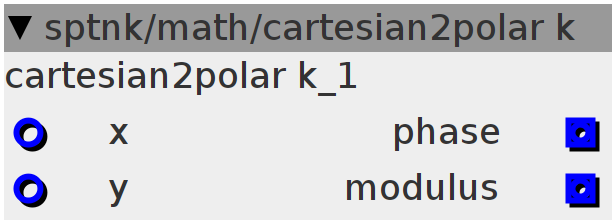cartesian2polar k
Converts a pair of cartesian coordinates into polar, K-rate Angles are mapped from 0,360 to 0,64. The arctan function is an approximation taken from http://www.embedded.com/design/other/4216719/Performing-efficient-arctangent-approximation , with a slightly modified coefficient.
Inlets
frac32 x
frac32 y
Outlets
frac32 phase
frac32 modulus
Declaration
float angle = 0;
float param = 0.849;
Control Rate
float x = inlet_x;
float y = inlet_y;
float x2 = x * x;
float y2 = y * y;
float xy = x * y;
int32_t region = 0;
bool sign_x = inlet_x > 0 ? 1 : 0;
bool sign_y = inlet_y > 0 ? 1 : 0;
bool yGx =
((sign_y ? inlet_y : -inlet_y) > (sign_x ? inlet_x : -inlet_x)); // |Y|>|X|
if (yGx) {
if (sign_y)
region = 2;
else
region = 4;
} else {
if (sign_x)
if (sign_y)
region = 1;
else
region = 5;
else
region = 3;
}
if (!inlet_x && !inlet_y)
region = 0;
switch (region) {
case 0:
break;
case 1:
angle = xy / (y2 + param * x2);
break; // 0<theta<45
case 2:
angle = 1.571f - xy / (x2 + param * y2);
break; // 45<theta<135
case 3:
angle = 3.142f + xy / (y2 + param * x2);
break; // 135<theta<225
case 4:
angle = 4.712f - xy / (x2 + param * y2);
break; // 225<theta<315
case 5:
angle = 6.283f + xy / (y2 + param * x2);
break; // 315<theta<360
}
outlet_modulus = (int32_t)_VSQRTF((x2 + y2));
outlet_phase = (int32_t)(angle * 21361415.0f); // 2^28 / 3.1415